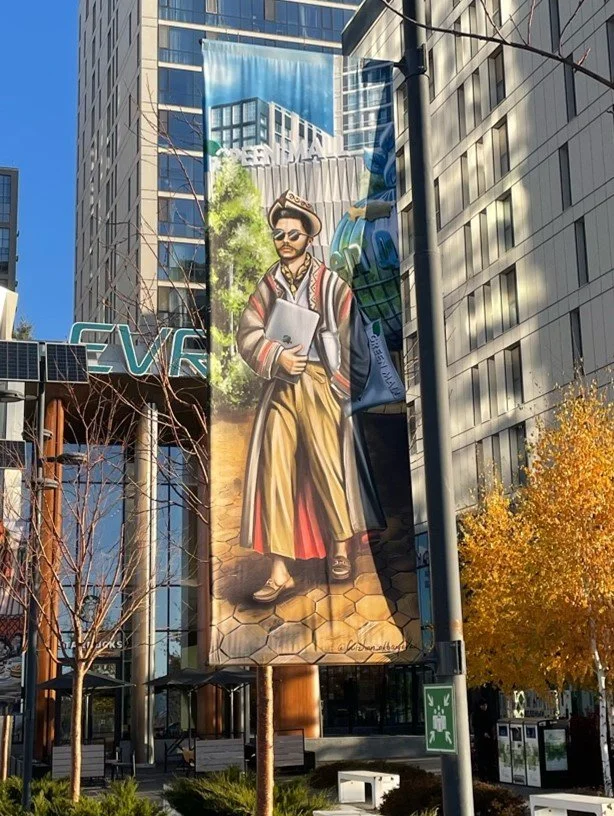Secrets of the Steppe II - Putin, Nail Techs and Taxi Drivers
Photo belongs to the author.
Year Abroad student Eve Mayes shares with us the weird and the wonderful of Astana, Kazakhstan, painting a picture of Central Asia that evades Western preconceptions of the area. In her first instalment, we learn about her journey there, and her initial impressions of the bustling streets, endless offices, and a humdrum of cosmopolitan life that, in its similarity to her life near London, has taken the edge off the culture-shock.
This entry includes two recent stories, both of which take place en route to a Nail Salon. Firstly, I want to clarify that in Cambridge, I would never have considered taking on the task of manicure up-keep – not only is it incredibly expensive, but the nearest salon is completely the opposite end of town from Churchill College. I’ll come back to the relevance of this in the second tale.
For now, back to the first story which took place as I was walking down Mangalik El Avenue - the main road through the centre of the city - to meet a friend at a salon. Since being here I’ve grown accustomed to seeing the occasional armed-guard, or police-car on watch, particularly in busy areas. On this day, however, I had noticed an unusual surplus of them along this stretch, as well as strangely quiet traffic. My heart stopped briefly when one of them approached me, asked me to stop walking and told me to stand to one side. Seconds later, an incredibly impressive and terrifyingly fast police escort whipped by, at the centre of which was an incredibly impressive black Jaguar. At this point, two things occurred. One - I realised Putin, in the capital for his meeting with Erdogan, had momentarily been approximately twenty metres away from me, the crowning jewel of any Slavonic year Abroad experience. Two – a citizen in his Toyota had tried to pull out of a hotel car park into the road. This innocent action sparked absolute fury from the guards, and an incredibly threatening reproach that I’m quite frankly glad was in Russian so I couldn’t understand the full extent of it.
Only weeks after the visit from the Pope, I was yet again incredibly impressed by the diplomatic centrality of Astana. A neutral meeting point for two Political leaders juggling complex and completely opposite relations with the West, Kazakhstan was again reinforced in its identity as an advocate for peaceful politics, at least in my mind. This seemed at total odds with the terrifying power of the authorities that became apparent at the moment of ‘the Toyota interjection’. I’ve since been struggling to reconcile these two conflicting traits of Kazakhstan: the near-idol status of political leaders that seems exquisitely preserved from Soviet times, when they (justifiably) feared for safety at any small public appearance and the general inclination to supporting democratic, peaceful politics. I am coming to the conclusion that they can’t be reconciled and that it is this very dichotomy that defines this country as its own cultural and political space in the modern world. Kazakh politics are a total knight’s move away from those of both the West and Russia.
More recently, also on the way to the Salon (though this time in a taxi, having been rather intimidated by the police during my last attempt to go on foot), I was engaged in conversation by a very chatty taxi driver. As seems to happen quite frequently here, the conversation quickly turned to “are you married yet?”. Sparked by the destination of the trip (the salon), this question revealed to me that while politically separate from Russia and the West, Kazakhstan’s culture manifests as an almost impossible combination of the two. Specifically, the inquisitor’s assumption that I wanted to make myself look good for someone played into both post-Soviet social-games of asserting status through appearance and enduring underlying patriarchal norms of Western society. Choosing not to focus on this at that very moment, I explained that I was only twenty and therefore not married, which was met with a chirpy “Well, it’s about time then!”.
If you ask a local to explain this tendency to marry younger here than in the West, they’ll simply say its normal – which is an entirely fair answer! Determined to dig a bit deeper though, I found some papers that suggest the tendency is a hangover effect from nomadic Steppe culture, where marrying women off was used as a method of justifying their participation in labour. As it turns out, it used to be unacceptable to actually hire women to work the land, but wives and children were fair game. It just so happens that in the modern context, this pressure on women to get married ties in incredibly neatly with the - I’m only slightly exaggerating - social imperative to constantly have a manicure.
When I pictured the Year Abroad experiences that would feel like lightbulb moments in my studies of culture and language I pictured local restaurants, hiking in mountains and bizarre cultural differences. I did not picture going to get my nails done, but somehow it is precisely this activity that, to me, has perfectly illustrated one of the peculiar combinations of cultural influences that substantiate Kazakhstan’s contemporary Identity.
Photo belongs to the author.

